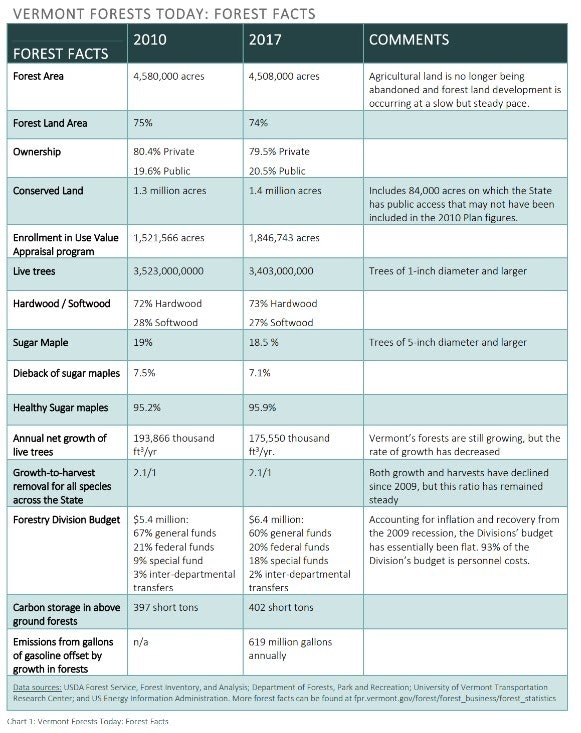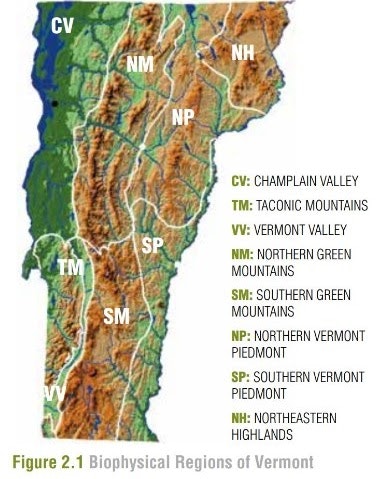Plants
Most of WRNRCD and ONRCD are part of the Southern Vermont Piedmont, although portions of the northern WRNRCD fall in the northern Vermont Piedmont and portions of the western ONRCD include the southern Green Mountains.
The Southern Vermont Piedmont is a variable region, with a cool climate in the northern hills, and some of the warmest temperatures in Vermont being recorded in Vernon. The topography comprises gentle, rolling hills that rise from the Connecticut River Valley to meet the Green Mountains. Northern hardwood forest dominates throughout, but oak and pine forests occupy warm southern and western slopes in the hills of the central and southern portions of the region. Hemlock forests are also common. The Connecticut River and its tributaries provide important aquatic habitat. These river valleys also have abundant deposits of sand and gravel resulting from the last glacial period in Vermont. Although many of these well-drained soils have been developed or processed for gravel, temperate climate oak and pine forests are common on those that remain. Floodplain forests are also common along many of the region’s rivers. The dense network of roads in this region has resulted in smaller blocks of forest and more fragmented wildlife habitat than in the less developed regions. Turkey, gray squirrel, and white-tailed deer are some of the species that benefit from the abundance of acorns.
Moderate in both its climate and topography, the Northern Vermont Piedmont is a hilly region bisected by many rivers. With rich soils derived from the underlying calcium-rich bedrock and gentle topography, this landscape is dominated by a dense network of roads connecting farms and small villages. Consequently, it contains fewer large forest blocks and has more fragmented wildlife habitat than in the Green Mountains and northeastern highlands. The calcium-rich bedrock is responsible for the abundance of rich northern hardwood forests, northern white cedar swamps, and rich fens—all characteristic communities of this region. In contrast, the acidic granite hills of Derby, Glover, and Groton State Forest support northern hardwoods with abundant spruce and fir. The granite quarried in Barre is world famous for its high quality. The Northern Vermont Piedmont has many lakes and ponds, including the larger Memphremagog, Seymour, and Caspian, as well as numerous smaller ponds in the vicinity of Woodbury and Groton State Forest. These lakes and ponds provide successful nesting habitat for the greatest concentration of common loons in Vermont.
This Southern Green Mountain region has high mountains (Killington Peak is 4,235 feet), acid bedrock composed of the same material as the Northern Green Mountains, cold temperatures, heavy precipitation, and dominated by the same forest types that are largely determined by elevation. One distinct feature of the Southern Green Mountains is the relatively level plateau on the southern and western sides of the region. Here, northern hardwood forest and spruce-fir forest intermix with spruce swamps, poor fens, and small ponds. Beaver are abundant and have had a significant influence on the wetlands of the plateau. Another distinct and dramatic feature of the Southern Green Mountains is the escarpment along the western boundary. The cliffs and steep slopes of the escarpment drop more than 1,000 feet in some areas to the valleys to the west. The escarpment’s acidic rock and warm western slopes support northern hardwoods, hemlock, and in many locations, oak and pine.
Thompson, E.H. and E.R. Sorenson. 2005. Wetland, Woodland, Wildland: A Guide to the Natural Communities of Vermont. Lebanon, NH: The Nature Conservancy and the Vermont Department of Fish and Wildlife. A second edition was released in 2019.


In 2017, the Vermont Forestry Division released a Forest Action Plan to address the forest resources concerns for the State. The overarching goal of the 2017 Plan was to minimize the loss of forest cover to conversion to other uses. The following list highlights other emerging issues, threats, and new strategies needed to ensure sustainable forests in Vermont.
- Continue to place priority on maintaining highly functioning forest lands for their ecological values, habitat and wildlife connectivity, and adaptive capacity during climate change. Strategies include encouraging working with partners in assessments and enhancing ecosystem integrity.
- Non-native invasive plants threaten to impact native regeneration, particularly in uninvaded forests. Strategies that track the spread of these species, support partnerships, and encourage efforts across property lines will promote integrated management.
- Climate change threatens our native tree species and the many valuable goods and services they provide. Implementation of strategies outlined in our 2015 document “Creating and Maintaining Resilient Forests in Vermont - Adapting to Climate Change” will be key to maintaining forests that can adapt to changing environmental conditions and stressors.
- Urban canopy enhancements can provide myriad social, economic, and ecological benefits. Continue to focus on communities that have less than average urban tree canopy, higher than average population, and high impervious surface area.
- The economic viability of Vermont’s working lands is challenged by changing land use, development pressure, and macroeconomic trends in the forest product economy. Maintaining focus and investment in Vermont’s working lands will grow forest businesses, improve our economy, and keep forests as forests.
- In Vermont, forest-based recreation has outpaced forest products in economic value. The demands on public land stretch staffing and raise resource concerns. Private lands represent an opportunity to provide forest-based recreation but will require support and guidance.
- Intergenerational transfer of forest land is a critical issue as Vermont’s population is aging. Working with partners to encourage estate planning is a key strategy.
The State of Vermont releases a Forest Condition Report to help track forest pests and their impacts. Highlight from the report, especially for pests localized in Orange and Windsor Counties, are listed here:
Maple leafcutter (MLC) Paraclemensia acerifoliella, damage is predominately found on sugar maples, although this insect also feeds on other hardwoods such as red maple, beech, and birch species. This insect caused observable damage to hardwoods during late summer and early autumn in 2021, causing our northern hardwood forests to appear brown and discolored before the onset of typical fall colors. Most reports of MLC came from Orange and Washington counties in 2021 (ANR).
Saddled prominent (SP), Heterocampa guttivitta, are hardwood defoliators native to the northeastern United States. Although a native insect, heavy and repeated defoliation can lead to dieback and mortality of infested hosts. Increased reports of defoliation during the growing season of 2020 led to reestablishing trapping efforts in 2021. In 2021, reports of defoliation were received from Franklin, Orange, Washington, Windsor, and Windham counties ANR.
Hemlock Woolly Adelgid (HWA), Adelges tsugae, continues to threaten hemlock trees in southern Vermont, especially in combination with drought and elongate hemlock scale. Traditionally infested sites are still infested, with no observed spread despite low winter mortality and higher population counts. Only 16 acres of hemlock decline related to HWA was mapped during aerial surveys. In the past, drought was observed to be the primary cause of symptoms on unhealthy hemlock trees in 2019 aerial surveys, a trend that would have likely been observed in 2020 if aerial surveys were conducted. As of 2021, known infested counties that were surveyed included Windham, Windsor, and Bennington counties. High-risk counties adjoining known infested counties were also surveyed including Rutland and Orange counties. High-risk areas, and plant hardiness zones 5a and 5b, in Windsor County, were also surveyed since Windsor County is only known to be infested at its southernmost edge.
Emerald Ash Borer (EAB), Agrilus planipennis, was first discovered in Vermont in February 2018, and new detections continued in 2021. As a result, EAB has now been confirmed in thirteen counties in the state. Emerald ash borer was detected in many significant new locations in 2021, including 15 new towns and two new counties. New towns include Belvidere, Berlin, Brookfield, Colchester, East Montpelier, Grand Isle, Hartford, Highgate, Middlebury, North Hero, Rupert, Saint Albans Town, Shaftsbury, Vernon, and Wilmington. New counties with EAB this year include Lamoille and Windsor counties.
Beech bark disease dieback, caused by Cryptococcus fagisuga and Nectria coccinea var. faginata, was mapped on 21,093 acres in 2021, an increase from the 15,073 acres mapped in 2019. Due to COVID restrictions, aerial surveys were not conducted in 2020. Bark symptoms remain common and crown symptoms are increasingly noticeable in mid-summer. This may be due to drought conditions that increased the survival of beech scale crawlers, the success of bark infections, and tree vulnerability. In addition, the 2019-20 winter had no prolonged cold snaps, and deep snow in some locations protected scales at the base of trees. Mapped acres of beech bark disease in 2021: Orange 506 ac Windsor 3097ac.
2020 Conditions Report_final.pdf